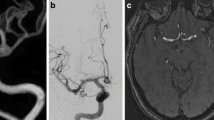Summary
Objective. To study the posibilities of the microsurgical management of ruptured intracranial aneurysms with the sole preoperative information provided by computed tomography angiography with three-dimensional reconstruction (3D-CTA).
Methods. Patients were studied with 3D-CTA after diagnosis of subarachnoid hemorrhage. If the study had an adequate quality and revealed an aneurysm congruent with the clinical findings or neurological examination and/or with the location of the bleeding on computed tomography (CT) scan an early microsurgical clipping of the lesion was done. When the quality of the 3D-CTA study was not adequate or the quality being adequate displayed no lesions or the findings were not accurate enough to warrant direct microsurgical treatment, the patient was studied with cerebral digital substraction (DS) angiography. A total of 44 consecutive patients harbouring a total of 47 intracranial aneurysms diagnosed by 3D-CTA and without preoperative DS angiography were submitted to microsurgical clipping and included in the study.
Results. The overall mortality was 15.9% and the favourable results evaluated 6 months after discharge by means of the Glasgow Outcome Scale reached 70.4%. All lesions were successfully clipped. Surgery was done a mean of 4.1 days after the admission bleeding. A total of four microlesions undiagnosed by 3D-CTA were found at surgery and clipped. Postoperative DS angiography and necropsy findings were also used as control of the 3D-CTA findings but no additional information was provided excepting the finding in DS angiography of an asymptomatic intracavernous aneurysm. Therefore the sensitivity of the 3D-CTA for diagnosis of symtomatic aneurysms was 100% and the overall sensitivity 90.4%.
Conclusions. We have reached similar results in patients operated on with or without preoperative angiography. 3D-CTA provides very valuable anatomical information, which has an additional value in the microsurgical treatment of aneurysms of the anterior communicating artery complex. Finally, selected cases of ruptured intracranial aneurysms can be successfully managed with the preoperative information provided by 3D-CTA and without DS angiography.
Similar content being viewed by others
Author information
Authors and Affiliations
Rights and permissions
About this article
Cite this article
González-Darder, J., Pesudo-Martı´nez, J. & Feliu-Tatay, R. Microsurgical Management of Cerebral Aneurysms Based in CT Angiography with Three-Dimensional Reconstruction (3D-CTA) and Without Preoperative Cerebral Angiography. Acta Neurochir (Wien) 143, 673–679 (2001). https://doi.org/10.1007/s007010170045
Issue Date:
DOI: https://doi.org/10.1007/s007010170045




